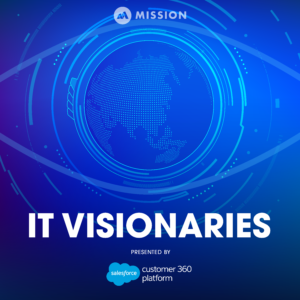Or listen in your favorite podcast app
Apple Podcasts / Google Podcasts / Spotify
Over the years, the idea of sustainability has changed and the metrics by which we measure it have shifted. So where are we on the sustainability timeline? And what should we be focusing on to become more sustainable in business and in life?
Here to answer those questions and more are Science journalist Wade Roush and Salesforce Vice President of Sustainability Patrick Flynn. On this episode of IT Visionaries, they discuss the current state of our sustainability efforts, as well as the lessons they’ve learned from the past and how to prepare for the future.
Key Takeaways:
- Corporate sustainability programs need to start in the places that are most relevant to the company as a whole.
- Prioritizing your efforts is important so that you do not get overwhelmed by the scope of the problem.
- Creating simple, repeatable frameworks that other companies can implement will be a difference-maker in the fight against climate change.
(For a more in-depth look at this episode, continue below.)
—-
The idea of sustainability has taken many forms throughout the decades, but all of these efforts have had one thing in common: they rely on measurable science and innovative technology. On IT Visionaries, we sat down with thought leaders from both of those sectors to have a discussion about what sustainability means today. From the world of science, we invited science journalist Wade Roush. And from the world of technology, we had Patrick Flynn, the Vice President of Sustainability at Salesforce.
Both men have done extensive research, reporting, and work in the area of climate change and sustainability efforts, and from all of that experience, these are their key findings:
On Corporate Sustainability Programs
As a corporate executive, Flynn spends a lot of time thinking about all of the stakeholders he serves. But when it comes to sustainability, we are all stakeholders, and Flynn believes that everyone has to serve it in the most efficient and effective way possible. For big businesses, serving the planet and looking at your own sustainability efforts starts with what is most relevant to the company as a whole and can expand from there.
“For us, like for most corporate sustainability programs, it begins by thinking about what’s most relevant to the business that we do as a cloud company,” Flynn said. “And so because of that, we think about things like data centers, offices, the electricity in particular that supports them. But Salesforce as a leader is driven to do so much more than just think about our own four walls. And so really these days, what my team and I spend most of our time thinking about is what are the big levers for change around us as a company? What are the big parts of the environmental system around us and how can we have an environmental impact that’s far, far bigger than the scale of Salesforce?”
It’s More Than Just Emissions
Thinking bigger is important because as Roush explains, the scope of the sustainability issue is much larger than just tracking emissions. It’s about infrastructure, inequality gaps, shipping cargo, removing carbon from the atmosphere, and more all at one time. It can be overwhelming to think about, but you can’t let the expansiveness of the problem scare you away.
“The larger your lens, the bigger the problem looks, and the more despair you might be tempted to feel,” Roush said. “On the other hand, every little thing you do can affect everything else. So from that perspective, it’s all one big effort. Everything that we do can help in some small way.”
What’s Most Urgent?
In that vein, Flynn advocates for prioritization. And from his standpoint, climate change is No. 1 on the priorities list because of the real threat it poses to the world.
“When prioritized appropriately, climate change stands out as the most urgent, most complex, most pervasive challenge of them all,” he said. “And perhaps the biggest and most complex challenge humans have ever faced. And to me in that complexity and the scale of that challenge is something that captivates me. This is the biggest puzzle that humans have ever tried to solve. And it touches absolutely everything we do. So I find so much captivation for me personally in trying to understand this huge and dynamic complex problem and figure out the right ways to address it.”
Look To The Past
Technology and human advancements have no doubt made addressing these complex problems easier. With supercomputing, data, analytics, new, quicker, more accurate testing of things like lead in water or carbon in the air, we are undoubtedly in a better position to address the challenges before us than ever before. And Wade also believes that disasters of the past have helped teach and prepare us for our current challenges and the ones to come.
“I’ve been studying disasters for 30 years and I think if they have a silver lining, it’s that they teach us that disasters do happen and that we need to be more prepared for the next one,” Roush said. “So from that perspective, I think we’re getting better and better at this. Sometimes it’s bumpy, but we’re getting better.”
Learn From Others
There is also an opportunity for companies to learn from each other and push each other further along. A company like Salesforce has committed to becoming carbon neutral and others can, too. They can also be more forward-looking and try to take action now that you’re future self and future company will want to take.
“We are all getting a crash course in looking at the data and trying to peer weeks into the future and act today as we would want to if we were standing in that future state and had a time machine to go backward,” Flynn said. “And that’s exactly what one does in the field of sustainability. If when looking at the climate crisis and thinking about the bold action that’s needed today, that makes perfect sense if you’re standing in 2050 and looking back on what you wish you had done in 2020. So I’m really hopeful that this is a global crash course in thinking about interconnected systems and using science to look into the future and act today based on that picture of the future that you see.”
So what does the future hold? Neither Roush nor Flynn can predict that, but they do have theories that it will be much different than our current reality. As companies like Tesla introduce cleaner transportation and others like Salesforce set an example of how cloud computing companies can become carbon neutral, we are seeing the impact that those advancements have. It’s up to all of us to make changes now so that our future selves and the generations that come after us will be able to keep moving the ball forward.




